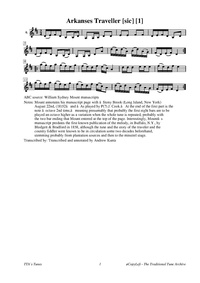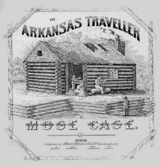Template:Pagina principale/Vetrina Alternativa

Played by: The Pine Tree String Band
Source: Soundcloud
Image: Sheet music crediting Mose Case

The music itself was in print in 1847, Rosenbaum states, and both the tune and the accompanying skit are presumed by him to have been in oral circulation at the time. Bayard (1981) thinks the whole melody may be an "American amalgam," as he was unable to locate a recognizable version in British Isles traditions.
The second strain became a "floater," according to him, and appears in otherwise unrelated tunes, and he speculates a portion of the first part may itself have been a 'floater' that became attached to the tune.
In Francis O'Neill's Waifs and Strays of Gaelic Melody (1922) "Arkansas Traveler" is regarded as having a 'presumable' Irish history and three tunes are given which are proffered as in part ancestral to the American melody. O’Neill says: “Vying in popularity with ‘Turkey in the Straw’, another American favorite claims our affection.
Famous in song and story, its origin has baffled investigation. An exhaustive research conducted by Dr. H.C. Mercer, an official of Buck's County Historical Society (Doylestown, Pa) relating to its history and antecedents failed of its purpose.
All lines of inquiry extending to Kentucky, Arkansas, and Louisiana, ended in contradiction, and uncertainty. Furthermore, the quaint dialogue between the ‘Traveler’ and the backwoods fiddler was based on nothing more substantial than a fertile imagination.
The opening paragraph of Dr. Mercer's essay published in the Century Magazine—On the track of the Arkansas Traveler—is well worth quoting:
Sometime about the year 1850 the American musical myth known as "The Arkansas Traveler" came into vogue among fiddlers. It is a quick reel tune with a backwoods story talked to it while played, that caught the ear at sideshows and circuses, and sounded over the trodden turf of fair grounds. Bands and foreign-bred musicians were above noticing it, but the people loved it, and kept time to it, while tramps and sailors carried it across the seas to vie merrily in Irish cabins with The Wind that Shakes the Barley and The Soldier's Joy.
...more at: Arkansas Traveler - full Score(s) and Annotations
X:0 T:Arkanses Traveller [sic] [1] M:2/4 L:1/8 S:William Sydney Mount manuscripts N:Mount annotates his manuscript page with “Stony Brook (Long Island, New York) N:August 22nd, (18)52” and “As played by P(?).J. Cook.” At the end of the first part is the N:note “octave 2nd time,” meaning presumably that probably the first eight bars are to be N:played an octave higher as a variation when the whole tune is repeated, probably with N:the two bar ending that Mount entered at the top of the page. Interestingly, Mount’s N:manuscript predates the first known publication of the melody, in Buffalo, N.Y., by N:Blodgett & Bradford in 1858, although the tune and the story of the traveler and the N:country fiddler were known to be in circulation some two decades beforehand, N:stemming probably from plantation sources and then to the minstrel stage. Z:Transcribed and annotated by Andrew Kuntz K:D V:1 clef=treble name="0." [V:1] (D/E/)F/D/ B,B,/D/ | A,A,/B,/ DD | EE FF | D/E/F/D/ B,D | (D/E/)F/D/ B,(B,/D/) | A,A,/B,/ DA | (d/c/)(d/A/) (B/d/)(A/G/) | (F/D/)(E/F/) D2 :| |:(a/g/)f/a/ (g/f/)e/g/ | (f/e/)d/f/ (e/c/)A2 | d/d/d e/e/e | (f/e/)d/f/ e2 | (a/g/)f/a/ (g/f/)e/g/ | (f/e/)d/f/ (e/c/)A | (d/c/)d/A/ (B/d/)A/G/ | (F/D/)E/F/ D2 :|]
